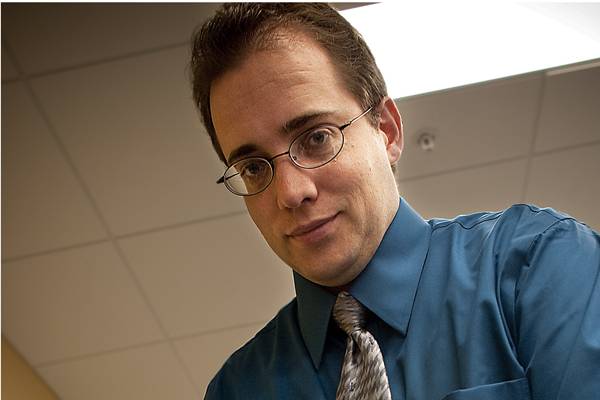Professor working to develop ultrasound to find breast cancer

Tim Bigelow, assistant professor in electrical and computer engineering, uses ultrasound to test an artificial tissue replica for cancer. His research involves ultrasound in both detecting and killing cancer cells. Photo: Laurel Scott/Iowa State Daily
October 21, 2009
The road to recovering from breast cancer can be a painful and starts with a painstaking procedure, a biopsy. An ISU professor hopes a current project will make the procedure unnecessary.
“If you talk to an M.D., it’s just a biopsy, but from a patient perspective it’s a very painful procedure. You stab someone with a giant needle, basically, and the cost associated with that is quite high,” said Timothy Bigelow, assistant professor in electrical and computer engineering and a consultant for the team working on the project. He said many patients refuse to have a biopsy, which is dangerous. By the time a patient learns whether a lump is cancerous without a biopsy, the patient may have missed the window for treatment.
The Quantitative Ultrasonic Imaging of the Breast project intends to improve current ultrasound imaging technology so a computer can interpret a signal to give some insight into the microstructure of the tumor in question. From this information, doctors could determine whether the tumor is benign or malignant and essentially give the same results of a biopsy without inserting anything into the body. Cutting down on biopsies by even 20 percent would provide the same peace of mind to the patient at a lower cost, Bigelow said.
The project is headed by William D. O’Brien, Jr., professor at the University of Illinois and private investigator of the project, and Timothy J. Hall, professor at the University of Wisconsin, Madison and co-private investigator. Bigelow and Yassin Labyed, graduate student assisting him with the project, are the only members of the team associated with Iowa State. It is a $4.7 million project funded by a grant from the National Institutes of Health.
Labyed said using ultrasound technology to detect tumors could potentially reduce the number of women who suffer from breast cancer. Ultrasound machines are cheap to use and every doctor’s office is equipped with one.
Women will be able to get their breasts checked each time they visit the doctor with this technology and avoid the possibility of getting an infection from the biopsy.
If doctors are able to detect abnormal tissue growth early, women will not need to endure expensive testing like MRIs.
The idea of using imaging technology for purposes like this has been around since the ’80s. It took time for the idea to develop into what it is today, and the kind of analysis needed for this type of procedure wasn’t possible without today’s technology.
The biggest challenge Bigelow has faced with the project is the quality of today’s ultrasound imaging technology.
The main reason the technology has not been implemented in this way so far, is that technicians need to know the loss of the signal along the path to the tumor.
“If you don’t know that accurately you can’t get a good estimate” Bigelow said.
The only place this kind of technology is only implemented at this point is for optical tumors, because the pathway to the tumor through the body is more straightforward than through the breast. The signal is basically traveling through water.
The projects current development is in the animal testing stage. The animal testing is done very humanely. Experiments on rats are done under anesthesia and the animals don’t feel any pain, Bigelow said.
The animal testing phase is set to be completed in May 2012. If the project is successful, it will move onto the next phase of clinical studies.
Bigelow said he believes the project has been quite successful so far.
–Daily Staff Writer Allison Suesse contributed to this article






